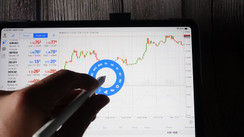The Ulcer Performance Index was developed by Peter Marin and Byron McCann in 1987 with the objective of analyzing mutual funds. It was first published in their book back in 1989 called "The investor's Guide to Fidelity Funds".
This indicator looks at the downside risk, not overall volatility. Other volatility measures, like standard deviation, consider the up and down movements equally. The name of this index come out thinking that the typical trader does not mind the upward movements and volatility, but that the downside volatility is what is causing all the stress. The name of the index “Ulcer” also refers to stomach ulcers, which were believed to be caused by stress.
What is the Ulcer Performance Index?
The Ulcer performance index is a market risk indicator. As we said before, it was created to measure the volatility specifically in the downward direction, meaning the degree of drawdown is retracements occurring over a period. Other volatility measures treat up and down movements equally, but it is the downside market sell-offs that cause more stress, and therefore need to be measured on their own.
Ulcer Index VS standard deviation of return
The Ulcer Index is a method for measuring investment risk and addresses the real concern of investors. This is different from the standard deviation of return; the Ulcer Index is in charge of regulating the depth and duration of drawdowns in prices from other earlier highs.
When using the Ulcer Index instead of the standard deviation of return can cause very different conclusions about investment risk and the risk-adjusted-performance. It depends on the strategy you are putting under evaluations.
The standard deviation is more of a statistical measure of the variability or unpredictability of an investment's return. But this method has some series drawbacks, such as the calculated value of standard deviation not being affected by the sequences in which gains and losses are occurring.
Calculating the Ulcer Index
The Ulcer Index is used to measure the depth and duration of drawdowns in price from earlier highs. To understand it better, the greater or more significant a reduction is in value, and the longer it takes to recover to previous highs, the higher will be the Ulcer Index. It's just like a squared percentage of drawdowns in value.
To calculate the Ulcer Index, you need to do it in three steps:
- Percentage Drawdown = [(Close - 14-period High Close)/14-period High Close] x 100
- Squared Average = (14-period Sum of Percentage Drawdown Squared)/14
- Ulcer Index = Square Root of Squared Average
- Also, this is how to calculate de Ulcer Performance Index:
- UPI = (Total return - Risk-free return) / UI
How can you use the index?
As a statistical measure, an investor can compare the Ulcer Index value to determine relative risk. It is perfect to use with weekly data. The index is used to measure the drawdowns, so it does a great job when it comes to knowing how your investments and risks are going. Investors can use the Ulcer Index to make their process more transparent.
It is effortless to use and apply, and it gives you the information you need to make better investments.





